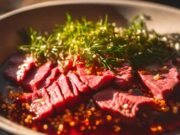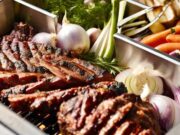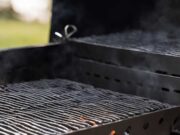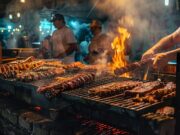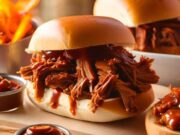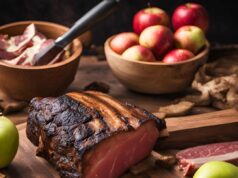Rotisserie cooking is a time-honored method that can elevate your grilling experience, delivering succulent, evenly cooked meats with a tantalizing finish.
The choice between gas and charcoal as your cooking fuel can significantly impact both the flavor and convenience of your meals. This discussion delves into the pros and cons of each fuel type, offering insights into their unique advantages and disadvantages.
Regardless of whether you are a seasoned grill master or a curious novice, understanding these differences will enable you to make an informed decision that aligns with your cooking style and preferences.
Key Takeaways:
- Gas rotisserie cooking offers convenience, temperature control, and quick cooking time, but may lack in flavor and require higher equipment costs and maintenance.
- Charcoal rotisserie cooking provides a unique smoky flavor, cost-effectiveness, and availability, but requires longer preparation time and temperature management challenges.
- When deciding between gas and charcoal for rotisserie cooking, consider the flavor, cooking efficiency, ease of use, and cost considerations to choose the best fit for your preferences and needs.
Understanding Rotisserie Cooking
Rotisserie cooking is a time-honored method that involves the slow roasting of meat on a spit, continuously rotated over a heat source, whether gas or charcoal. This technique ensures evenly cooked and flavorful results.
Culinary enthusiasts have embraced rotisserie cooking for centuries, with its origins tracing back to ancient civilizations that utilized both direct and indirect heating to roast various types of meat effectively.
Overview of Cooking Fuels
In the realm of culinary arts, it is essential for you to understand the various cooking fuels available to achieve optimal results, especially in rotisserie cooking. Gas and charcoal are the two most popular fuels utilized in grills and smokers, each offering distinct benefits and flavor profiles that can significantly influence the final outcome of your grilled meats, including steaks, chicken, brisket, and pork.
Gas Rotisserie Cooking
Gas rotisserie cooking offers a contemporary and efficient method for preparing perfectly roasted meats, allowing you to utilize propane or natural gas with precise temperature control and quick ignition.
The efficiency of gas grills, indicated by their BTU (British Thermal Units), ensures consistent cooking that reduces the risk of burning while still delivering delicious flavor and attractive grill marks on your preferred cuts of meat.
Advantages of Gas Rotisserie Cooking
The advantages of gas rotisserie cooking lie in its exceptional convenience and ease of use, appealing to both novice and experienced grillers alike. With the ability to ignite the grill quickly and maintain precise temperature control, gas rotisserie cooking significantly reduces preparation time. This allows chefs to focus more on seasoning and flavoring their meats while ensuring even cooking throughout.
This method consistently delivers excellent cooking results, making it ideal for those who desire perfectly roasted dishes every time. Additionally, the energy efficiency of gas systems allows for longer cooking durations without the concern of running out of fuel. The rotating feature helps ensure that the meat retains its juices, enhancing flavor and tenderness.
Cleanup is typically straightforward, enabling you to spend more quality time enjoying meals with family and friends, free from the burden of extensive post-cooking chores.
Disadvantages of Gas Rotisserie Cooking
Gas rotisserie cooking offers numerous benefits, but it also presents certain disadvantages, particularly concerning flavor and potential costs. While gas grills provide excellent temperature control and quick heat-up times, they may not deliver the deep, smoky flavor that charcoal or wood can offer, which may disappoint those who seek the ultimate barbecue experience.
If you are considering this cooking method, it is important to be aware of the initial investment required for high-quality rotisserie equipment, which can be a barrier for budget-conscious cooks. Additionally, maintaining a gas unit necessitates regular checks on connections and burner systems to ensure safe operation, which may lead to extra expenses over time.
The need for consistent upkeep might discourage some enthusiasts who prefer the simplicity and lower maintenance associated with charcoal smokers. Collectively, these factors highlight that while gas rotisseries provide convenience, they may fall short in delivering unique flavors and can incur a higher overall cost of ownership.
Charcoal Rotisserie Cooking
Charcoal rotisserie cooking is recognized for its ability to impart a distinct and appealing smoky flavor to meats, making it a preferred method among barbecue enthusiasts.
This traditional technique utilizes charcoal as the primary heat source, providing a cost-effective solution while delivering a robust cooking experience. However, it is important to note that managing the temperature can present some challenges.
Advantages of Charcoal Rotisserie Cooking
The primary advantage of charcoal rotisserie cooking lies in the distinctive smoky flavor it imparts to meats, enhancing dishes such as steaks, briskets, and chicken with a level of complexity that gas cooking often lacks. Charcoal is widely available and typically more cost-effective compared to gas, making it a popular choice for outdoor cooking enthusiasts.
This method not only elevates flavor but also fosters a deeper connection to the traditional grilling experience. Unlike other cooking methods, charcoal rotisserie cooking allows the natural juices of the meat to meld with that smoky essence, creating an irresistible aroma that enhances gatherings.
The affordability of charcoal enables more individuals to enjoy this culinary style, whether in their backyards or at parks, paving the way for memorable meals without straining the budget. Consequently, it stands out as both a practical and flavorful option for grilling enthusiasts as well as casual cooks.
Disadvantages of Charcoal Rotisserie Cooking
While charcoal rotisserie cooking offers remarkable flavor, it also comes with several disadvantages, particularly regarding preparation time and temperature management. Unlike gas grills that ignite instantly, charcoal requires a considerable amount of time for the coals to reach the desired heat levels. Maintaining consistent temperatures can be especially challenging for those who are new to this cooking method.
A lack of experience with charcoal can result in burnt or undercooked meals, as the learning curve can be steep. Properly positioning the rotisserie and adapting cooking times based on the type of meat and the surrounding environment add further complexity. You will need to monitor flare-ups and adjust airflow to manage heat effectively, making the process more intricate than simply placing food on a heating element.

Mastering these skills can significantly enhance the final result, but it requires patience and practice, which may deter some cooks who are seeking a more streamlined approach.
Comparative Analysis: Gas vs. Charcoal for Rotisserie Cooking
When comparing gas and charcoal for rotisserie cooking, it is essential to evaluate the key differences in flavor profiles, cooking efficiency, and ease of use to identify the best option for your culinary requirements.
Gas offers convenience and precise temperature control, making it an efficient choice for many cooks. In contrast, charcoal imparts a richer, smoky flavor that many consider essential for achieving authentic barbecue results.
Flavor Comparison
The flavor comparison between gas and charcoal rotisserie cooking reveals distinct taste profiles that can significantly influence the overall dining experience. Gas cooking typically produces cleaner, more subtle flavors, while charcoal imparts that classic smokiness, enhancing the natural taste of meats such as chicken and pork.
This difference in flavor dynamics can alter how a meal is perceived by your guests. For example, when slow-roasting a tender brisket, gas may provide a more straightforward taste, allowing the spices to shine without overpowering them. In contrast, charcoal infuses a rich, deep essence that complements and rounds out the meat’s flavor, particularly when combined with marinades or dry rubs.
Those who appreciate both methods often engage in debates about their merits, recognizing that while gas offers convenience and precise temperature control, charcoal can elevate the sensory experience by intertwining the aroma of wood smoke with the hearty goodness of grilled meats.
Cooking Efficiency
Cooking efficiency is a critical factor where gas and charcoal rotisserie cooking differ significantly, particularly when it comes to cooking times and temperature control. Gas rotisserie setups generally heat up quickly and provide consistent heat, resulting in shorter cooking durations. In contrast, charcoal requires more time for preparation and can experience fluctuations in temperature.
This difference in heating methods not only impacts cooking times but also affects the overall user experience. Users who opt for gas often appreciate the convenience of immediate ignition and steady flames, allowing for straightforward meal preparation without the need for constant monitoring. On the other hand, those who choose charcoal may find the ritual of lighting fires and tending to coals appealing, as it often imparts a unique flavor and smoky aroma to dishes. However, this approach can complicate time management and meal planning.
Ultimately, you must weigh the benefits of quick and steady cooking against the traditional charm of charcoal grilling to determine which method aligns best with your culinary preferences.
Ease of Use
When considering ease of use, gas rotisserie cooking often stands out as the preferred choice, especially for beginners who may find charcoal grilling intimidating. With user-friendly features like temperature dials and quick ignition, gas grills streamline the cooking process, whereas charcoal requires more skill in managing coals and achieving the optimal heat for cooking.
For many, the straightforward setup of gas grills translates to less time spent on preparation and more time enjoying the grilling experience. They typically heat up quickly and maintain stable temperatures, significantly enhancing the overall cooking process.
Conversely, charcoal grilling, while offering a distinctive flavor, entails a more complex setup that involves igniting coals and waiting for them to reach the desired temperature. The cleanup after charcoal grilling can also be more labor-intensive due to the leftover ash, whereas gas grills often come equipped with convenient features such as removable drip trays that simplify maintenance.
Ultimately, those new to grilling may find gas options to be a more accessible and manageable choice.
Cost Considerations
Cost considerations are crucial when deciding between gas and charcoal rotisserie cooking, as they affect both the initial investment and ongoing expenses. While gas grills often have higher upfront costs due to their complex equipment and propane requirements, charcoal grills typically present lower overall costs, though you may incur additional expenses for charcoal and necessary accessories.
It is essential to analyze the recurring fuel costs; charcoal generally offers a more economical option per cooking session compared to propane. You should also consider the long-term implications of each choice, including maintenance and durability. Gas units often require fewer replacement parts and tend to have a longer lifespan, resulting in greater savings over time.
However, for some enthusiasts, the unique flavor profile achieved through charcoal cooking may justify the ongoing expenses, making the decision not solely financial but also a matter of culinary preference.
FAQs
When engaging in rotisserie cooking with gas or charcoal, you may encounter several common questions that arise among enthusiasts, ranging from safety concerns to effective cooking tips. Familiarizing yourself with these frequently asked questions can give the power to you to make informed decisions and enhance your skills in preparing delicious meals, regardless of the fuel you choose.
Frequently Asked Questions
What are the main differences between rotisserie cooking with gas and charcoal?
The main difference between rotisserie cooking with gas and charcoal is the source of heat. Gas grills use propane or natural gas to generate heat, while charcoal grills use charcoal briquettes or lump charcoal.
What are the pros of using a gas grill for rotisserie cooking?
One of the pros of using a gas grill for rotisserie cooking is convenience. It is quick and easy to start the grill and adjust the heat. Additionally, gas grills often have multiple burners, allowing for more control over the heat and cooking different types of food simultaneously.
What are the advantages of using a charcoal grill for rotisserie cooking?
Charcoal grills are known for producing a smoky flavor that is highly desirable in grilled food. They also reach higher temperatures, making them great for searing meats and achieving a crispy exterior. Charcoal grills are also typically more affordable than gas grills.
Are there any downsides to using a gas grill for rotisserie cooking?
One downside of using a gas grill for rotisserie cooking is that it may not impart as much flavor to the food as a charcoal grill. Some people also argue that food cooked on gas grills does not have the same “charred” taste that can be achieved with charcoal grills.
What are the cons of using a charcoal grill for rotisserie cooking?
One of the main drawbacks of using a charcoal grill is the time it takes to get the coals ready for cooking. It can also be more challenging to control the heat on a charcoal grill, and cleaning up the ash can be messy. Additionally, charcoal grills may be more expensive in the long run, as charcoal needs to be replaced regularly.
Can you use a rotisserie kit on both gas and charcoal grills?
Yes, rotisserie kits are versatile and can be used on both gas and charcoal grills. However, it is essential to make sure the kit is compatible with your specific grill model before using it. Some manufacturers may offer different kits for gas and charcoal grills, so be sure to check before purchasing.









